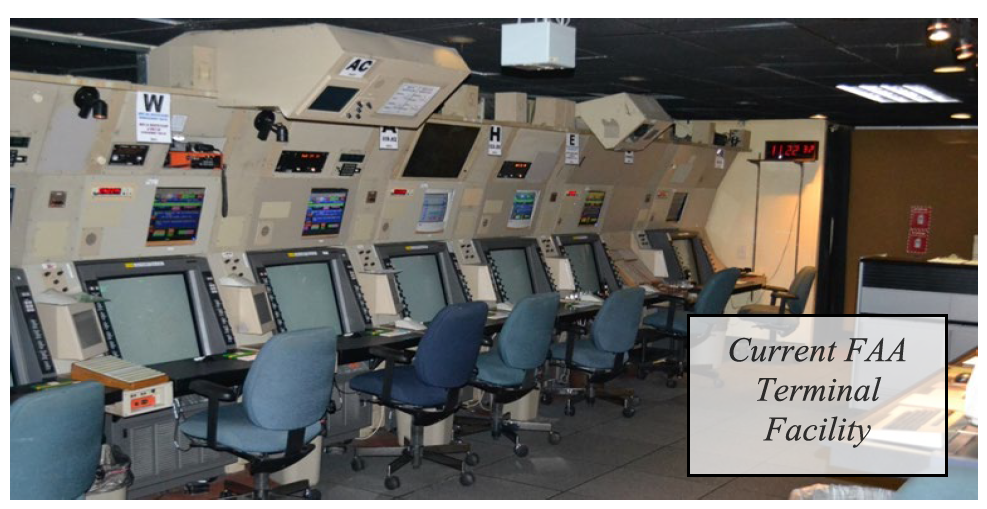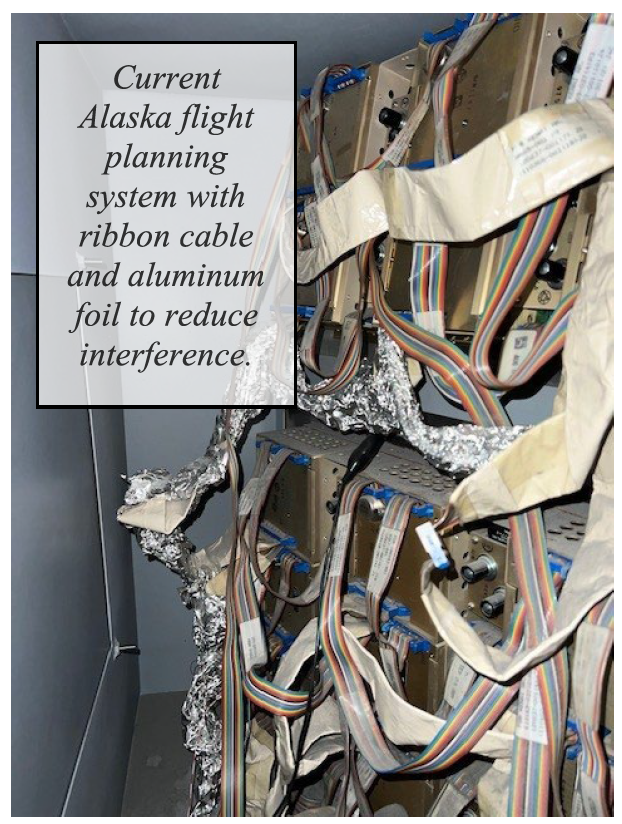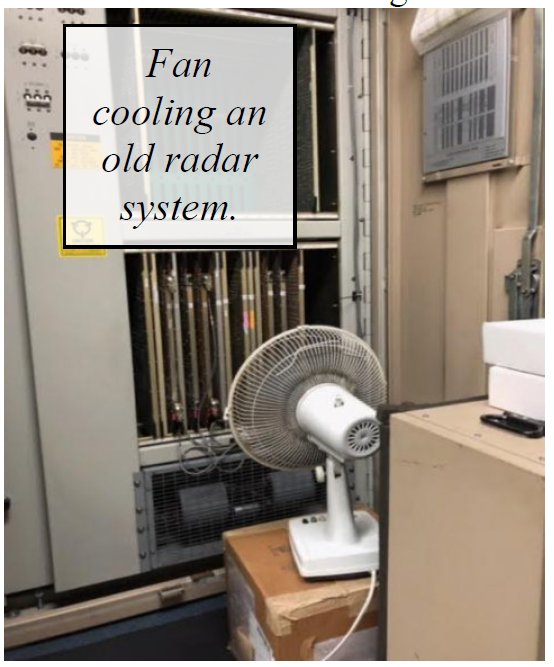The Trump administration wants to fix air traffic control by throwing an indeterminate amount of money at upgrading aging technology. Their plan takes the approach laid out in the opening to The Hitchhikers’ Guide To The Galaxy.
This planet has – or rather had – a problem, which was this: most of the people living on it were unhappy for pretty much of the time. Many solutions were suggested for this problem, but most of these were largely concerned with the movement of small green pieces of paper, which was odd because on the whole it wasn’t the small green pieces of paper that were unhappy.
Transportation Secretary Sean Duffy laid out many of the ways that U.S. air traffic control is a technological mess. So he wants to spend a secret amount of money fixing it. That’s exactly the approach the FAA has taken for more than 40 years without fixing it.
A review of more than 20 government oversight reports dating back almost half a century shows the agency has repeatedly struggled to modernize its air-traffic systems.
The FAA’s work to overhaul air-traffic control traces back to 1981, when it estimated the effort would cost $12 billion over 10 years. The Government Accountability Office, a congressional watchdog, twice designated the overhaul a “high-risk” project in the 1990s. By 2003, two decades and $35 billion after beginning the effort, the FAA’s cost estimate had ballooned to $51 billion and was 16 years behind schedule. The same year, the FAA began transforming its radar-based system to draw on satellite navigation to expand its capacity and improve safety.



There is no proposal to fix the FAA itself, creating any accountability or performance metrics. There’s a leadership and cultural problem at the Air Traffic Organization that designs in failure. ‘Moving little green pieces of paper around’ isn’t going to fix that.
Instead, the plan is to throw a lot of money at an agency that’s been unable to deliver for as long as I’ve been alive. What is their procurement process like?
The first step in the process is to establish system requirements. Having been intimately involved in a few of these efforts, this process is very much in need of improvement. FAA has designated random FAA controllers to establish requirements, without extensive knowledge of the system they are replacing and with no training on how to develop requirements to hand off to engineering teams. This process lacks value engineering as an essential part of the process. The result is gold-plating ATC [air traffic control] requirements, and sometimes demanding capabilities that are not cost-effective or technologically feasible.
…engineering programs run by non-engineers, operations run by non-operational people, logistics run by non-logisticians. The systems engineering that FAA once had has been destroyed…
…The last failed attempt by FAA to solve the surveillance conundrum was named SENSR. Now there is a new program called ANSR (Aircraft Non-cooperative Surveillance Radar), which has little chance of being deployed in the next 15 years, even if it is fully funded by Congress.
Here’s Air Transport Association (now Airlines 4 America) veteran and former FAA consultant Gary Church, via the inestimable Bob Poole,
The problem with FAA procurement is that initial failures lead to more and more convoluted processes that contribute nothing but add layers of procurement complexity. A big one is a cost-benefit analysis that wants not an 80% solution but a 99% solution, which takes more and more time to acquire data and analyze. While doing this, your 18 months to make a relevant decision becomes three, four, or five years. In that time, all the technology and assumptions change. If you can’t make a cost/benefit procurement decision within 18 months, you have lost the window and any opportunity of making a good decision. Second, based on analyzing FAA’s process, I conclude that you will never get to a successful procurement following the details prescribed in the FAA documentation…Every notable FAA procurement failure over the years has just added complexity and delay to cost analysis and systems engineering processes, until today they are virtually unworkable: you just can’t get a product out the door.

We need to split out the FAA’s Air Traffic Organization which provides air traffic control services from the regulatory function of the agency. The FAA shouldn’t be regulating itself. That leads to zero accountability. That’s an ICAO best practice followed by most of the world. I worry that alone isn’t enough (government rail Amtrak has a separate regulator). The NavCanada model is better, with an independent stakeholder nonprofit, which can issue bonds for long-term capital needs and pay them off with user fees. It’s no coincidence they’re decades ahead of the FAA in technology.


Tr*mp sucks that is all
This smells like a tRump “I’ want my cut too” scenario.
The system seems hopelessly bogged down. I think of General Grant during the Civil War. He had to decide between two contractors to get the supplies his army badly needed. He read over their proposals and picked one. When asked how he knew it was the best decision his answer was, “I don’t. If it is not we’ll know in a week. But it is fatal to waste time deciding on such an important matter.” That’s an attitude and process which are long gone.
This is why Kamala Harris would have saved us? She would have continued Biden’s effort to fix the system and would have finished by about 2028, 2029 at the latest. Biden was the greatest and Harris was right up there with him in the rankings in US history.
Matthew of Live and Let’s Fly takes a different view and thinks it’s a good start unlike Gary. Who is right?
This whole article is a lie and is full of shit – just like “Unintimidated. Just like the border, President Trump will update and FIX this problem.
Everyone wants to compare our system to NAVcanada. The biggest issue is that the US airspace is exponentially busier and more complicated than any of Canadas airspace, and anywhere else in the world. As a controller I can attest firsthand to how outdated our tech is, but simply thinking we can take something another country did and implement that simply isn’t possible. Hopefully this at least gets the ball rolling on updates, but the timeline to make these types of changes actually happen will extend through multiple administrations and likely cost significantly more than they claim it will.
I am shocked, shocked that Trump can not IMMEDIATELY fix a 40 year old broken down FAA system, ignored by past Presidents and past Congresses ( hi Schumer). I am certain Kamala would have fixed it sooner.
Let me guess this right: This system has been hopelessly inadequate for 40 years, and less than 4 months into his Presidency you try to make the case that Trump is at fault ? Candidly Gary, this is garbage and you should know better.
I believe they need to replace senior management at the FAA and replace them with competitent experts. Secondly they need to find out into which politician’s pockets all those billions of dollars went and prosecute those responsible. President Trump is doing a remarkable job considering the pile of crap he was handed. The system can be fixed but it is going to cost an extensive amount. But ask yourself one question….how much is air safety worth?
Why did he not fix it during his first term?
This is a really common problem in the federal gov’t. My friend worked at a radio telescope; spec’ed out in 1985 so by the time it was actually operational in 1991 the hardware was already a bit long in the tooth. When he retired a few years ago they had already been doing board-level resoldering for about 10 years, items they already had 1 spare of per site had 0 or 1 spare throughout the multiple sites (often damage was due to lightning strikes). You have this long specification process, and then a while before that goes through procurement and finally gets built, it makes it really tricky in cases where the technology advances particularly quickly.
That radar box with the fan blowing into it looks an awful lot like an old VMEBus system, which is the type of thing commonly used in the 1980s. That’s one of those buses uses for industrial purposes so it was spec’ed in 1982 and you can still actually get VMEBus enclosures and such today for industrial and scientific systems.
A great description of the problems at the FAA!
It’s a real shame because if we were going to do ‘a fascism’ it would have sure been nice to at least get ‘the (planes) to run on-time’ and maybe like high-speed rail or an autobahn; instead, it’s just grift, corruption, and incompetence. A kleptocracy mixed with a kakistocracy. We knew better, yet our people chose the con-man a second time. The ‘developer’ couldn’t even do ‘infrastructure week’ the first or second time. So, we’ll watch it fail. Then, once this second Gilded Age is finally over, we can fix it in a new Progressive Era hopefully soon.
Lol, guys. This has to be fixed but to blame Trump on this over any of the other 10 presidents is a bit much.
Now, if Trump promised to have this done in 2 years and it won’t……..
Then welcome to Washington. 🙁
@TexasTJ – how on earth do you get that I think ‘Trump is at fault’ for the atc mess? I’m simply saying this new push is unlikely to solve it.
@Ron – (1) NavCanada handles traffic over the North Atlantic, not just within Canada. (2) It isn’t just NavCanada, compare to even NATS or DANS in Dubai.
America’s infrastructure from roads, to airports, to railways to public transportation is a third world mess. There’s no investment. There never has been. The country has spent trillions on “nation building”, NASA, and perpetuating the notion it is the greatest nation the world has ever known, for the past 100 years, but one can’t drive on a street without hitting pothole. The country is nearly bankrupt and headed for a stagflation-laden, deep recession.
Where is my Exit Bag. This place SUCKS.
I am no fan of Trump (quite the opposite, in fact), but laying this at feet of Trump is just political chest thumping. This has been a known issue for FORTY YEARS. Multiple GOP and Democratic presidents and Congresses have kicked the can down the road. Why? Because too many people who vote are greedy and only interested in what lines their pockets with more money. Neither Congress nor multiple presidents have had the intestinal fortitude to tell America the truth…we either fix this or planes will crash and people will die.
One mid-air collision and now we have a crisis on our hands? That’s complete BS. This crisis has been brewing for years while every politician hoped it did not blow up on their watch.
All of this said, throwing money at the problem is not the solution, nor is just a quick fix. People need to step back, consider what air transportation will look like in 20 years and how the ATC system needs to respond and how it must respond with a shrinking workforce that is being overworked to the breaking point. There needs to be a strategy here. Sadly, I have no faith in either political party to see that through.
Enough with the politics Gary! We know you are a raging TDS democrat already. Keep politics out of travel!
@Adam T politics are what ensure Gary has enough clicks and posts. Without fanning the flames of our culture wars there would be about half the posts there are. Imagine what that would do to his business model.
Fair point Gary, as you say “how on earth do you get that I think ‘Trump is at fault’ for the atc mess? I’m simply saying this new push is unlikely to solve it”. That said, your title: “Trump’s FAA ‘Fix’: Spend Billions More Without Changing The Broken System That Doomed The Last 40 Years” does come across as uncomplimentary about Trump. In addition, my guess would be that Trump isn’t even aware of the technical details, this would be developed by Sean Duffy and the FAA Team. As heavy air travelers, my guess is that the one thing we can agree on is that the current situation is an unmitigated disaster, and change is needed fast.
@TexasTJ – This is the Trump administration’s fix, in fact it is more than that – Trump called into the announcement. He’s personally behind it. And it’s not enough to solve the problem. In terms of ‘not being aware of the details’ that is on him.
@AdamT “We know you are a raging TDS democrat already.” Okey dokey.
@Parker,
Very articulate and honest appraisal of the current (40 yrs on) issue with the ATC systems in this country.
It needs modernization yesterday. It will take billions, that former administrations failed to address. Not patchwork, but a real overhaul.
@Parker, Thank you for an objective post, rather than the TDS type of rants.
A lot of people letting their political opinions get in the way of actually paying attention.
Gary isn’t blaming The Felon for the mess–it predates him, of course it can’t be his fault. What Gary is blaming him for, correctly I think, is attempting to fix this by throwing money at it without doing anything about the real problems.
1) As mentioned by a couple of others, the procurement system is way too slow. They bend over backwards to avoid corrupt dealings so there is endless dispute over the details rather than accountability for actually doing it right. Does it fit the specs rather than does it do the job. And of course there are going to be design errors, the “blame” is wholly attached to the government even when whoever was doing the work often knew better.
2) Maintenance isn’t something to bring home to the voters, it always gets the short end of the stick. But it ends up costing more because old things should have been replaced long ago.
3) Politicians love to do things. It’s “better” to institute a new solution rather than fix the existing stuff. The end result is a huge amount of duplication of effort. DOGE is “trying” to address this, but with a chainsaw rather than a scalpel. The result is worse than inaction.